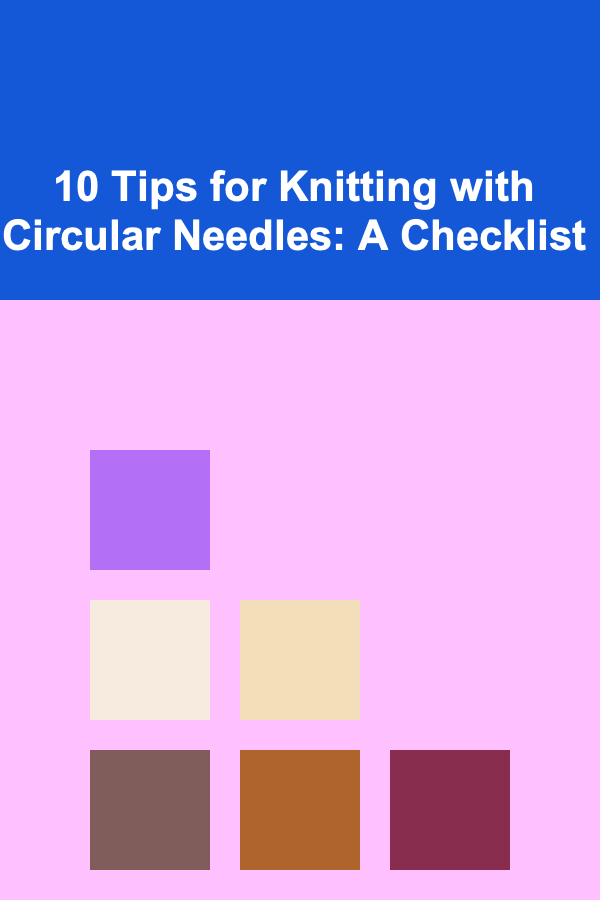
10 Tips for Knitting with Circular Needles: A Checklist
ebook include PDF & Audio bundle (Micro Guide)
$12.99$7.99
Limited Time Offer! Order within the next:

Knitting with circular needles opens up a whole new world of possibilities for knitters, offering the flexibility to create seamless projects, as well as the ability to knit larger items such as blankets, sweaters, and shawls. Whether you're a beginner or an experienced knitter, mastering circular needles can greatly improve your knitting experience and expand your crafting options. In this article, we'll go over 10 essential tips to help you become proficient in using circular needles.
These tips will guide you in avoiding common mistakes, ensuring your projects turn out beautifully, and making your knitting sessions enjoyable.
Understand the Basics of Circular Needles
Before diving into techniques and tips, it's essential to have a solid understanding of circular needles and their components. Circular needles consist of two needle tips connected by a flexible cable. They come in various lengths and needle sizes, making them suitable for a wide range of projects.
Choosing the Right Circular Needle
- Length of the Cable: Circular needles come in different lengths, typically ranging from 16 inches to 40 inches (or more). A longer cable is ideal for larger projects such as blankets, shawls, or sweaters, while shorter cables are better for smaller projects like hats and socks.
- Needle Size: Just like straight needles, circular needles come in various sizes to accommodate different yarn thicknesses. Always refer to your pattern for the recommended size.
- Material: Circular needles are available in different materials, including metal, bamboo, and plastic. The material of the needle affects the smoothness of your stitches and how they glide on the needle.
Tip: If you're unsure of which circular needle to use, consider the size and nature of your project. For smaller projects, you might want to start with a 16-inch cable, while larger projects typically require cables of 24 inches or longer.
Cast On with the Right Technique
Casting on with circular needles may feel a bit different from using straight needles, but once you get the hang of it, it's no more complicated. The key is to ensure that the stitches are evenly distributed around the needle.
The Long-Tail Cast-On Method
For a flexible, neat, and stretchy edge, the long-tail cast-on method is ideal. Here's how to cast on using circular needles:
- Measure the Yarn: Start by measuring the appropriate length of yarn to make a long tail.
- Hold the Yarn: Hold the working yarn in your left hand and the tail in your right hand.
- Make a Slip Knot: Create a slip knot and place it on the left needle.
- Cast on Stitches: Use your thumb and index finger to create the necessary number of cast-on stitches, placing them evenly on the needle.
Tip: Be mindful of your tension. Loose or tight cast-on stitches can affect the overall appearance and comfort of your knitted fabric.
Keep the Yarn Tension Consistent
One of the key factors in creating a uniform and smooth project is keeping your yarn tension consistent. Circular needles can sometimes encourage uneven tension because the stitches can slide around on the cable. Here's how to avoid tension issues:
- Hold the Yarn Firmly but Gently: Don't grip the yarn too tightly or too loosely. You should aim for a relaxed yet consistent hold.
- Keep Your Stitches Even: Check for any tight or loose stitches as you go along. If you notice any, adjust your tension by slightly loosening or tightening your grip on the yarn.
- Use Stitch Markers: For more complex projects, use stitch markers to remind yourself of stitch counts and patterns, making it easier to spot any inconsistencies.
Tip: If you find that your stitches are too tight, consider using a larger needle size to achieve the desired tension. Conversely, if your stitches are too loose, try using a smaller needle.
Master the Magic Loop Method
One of the most popular techniques for knitting small projects, such as socks or sleeves, with circular needles is the "magic loop" method. This technique involves using a long cable to knit in the round, allowing you to knit projects that would typically require double-pointed needles.
Steps to Knit with Magic Loop
- Cast on your stitches and slide them to the center of the cable.
- Divide the Stitches: Fold the cable in half, placing half of the stitches on each side of the loop.
- Join in the Round: Knit the first half of the stitches as usual. When you reach the end, pull the cable through to the other side and continue knitting the second half.
- Adjust the Cable: Keep adjusting the cable as you knit to ensure the stitches remain taut and even.
Tip: Magic loop is a great technique for knitting in the round with circular needles, especially when you don't have a set of double-pointed needles. It can be tricky at first, but with practice, it becomes intuitive.
Avoiding Twists in Your Work
One common issue when using circular needles is getting a twist in the fabric as you join the round. A twisted project can lead to frustration and mistakes, but there are a few tricks to avoid this problem:
- Check Before Joining: Before you join in the round, make sure all of your stitches are properly aligned and not twisted around the cable. If the stitches are twisted, simply adjust them.
- Use a Stitch Marker: Place a stitch marker at the start of the round to remind yourself where the beginning is, making it easier to check for twists as you progress.
- Lay the Work Flat: Before starting your round, lay the project flat on a surface to ensure the stitches are facing the same direction and there's no twist.
Tip: If you accidentally twist your stitches, don't panic. Simply take the stitches off the needle and carefully untwist them before starting again.
Switching Between Circular and Straight Needles
Some projects may require switching between circular needles and straight needles, especially when you need to knit a flat piece or work on a project like a sweater with back and front panels. If you need to make this transition, here's how to do it smoothly:
- Use Circular Needles for Flat Projects: You can knit flat projects with circular needles by simply turning the work at the end of each row.
- Switch to Straight Needles: If you need to switch to straight needles for a section, use a longer circular needle or try a shorter length of cable for more control.
Tip: If you're used to working with straight needles, it may feel awkward to switch between circular and straight. Practice with smaller projects to get comfortable with both types of needles.
Managing the Cable
Circular needles come with a flexible cable that allows you to knit large projects in the round, but managing the cable properly is key to making your knitting smooth and enjoyable. Here are a few tips:
- Prevent Tangling: Keep the cable from tangling by looping it loosely when not in use. If the cable gets too kinked, run it under warm water or use a gentle iron to straighten it.
- Use Circular Needles for Flat Projects: For projects that require flat knitting, simply knit back and forth on the circular needles. The long cable doesn't interfere with the process as long as you manage your tension and positioning.
Tip: If the cable becomes too stiff, try soaking it in warm water to soften it, which can make the needles easier to handle.
Learn to Knit in the Round Seamlessly
One of the primary benefits of circular needles is the ability to knit in the round without seams, making projects like socks, hats, and seamless sweaters possible. To knit seamlessly, follow these tips:
- Join the Round Carefully: After casting on, take care to join the round without twisting your stitches. You can use a stitch marker to keep track of the round's beginning.
- Keep the Tension Even: Maintain a consistent yarn tension as you knit in the round to ensure the work is seamless and even.
- Mind Your Gauge: Be sure to check your gauge frequently to ensure that the size of your project is turning out as expected.
Tip: To make seamless knitting easier, consider using stitch markers to highlight key areas and keep track of any increases or decreases in the round.
Adjust for Different Project Sizes
Circular needles can be used for a variety of projects, from small items like socks to large projects like blankets or shawls. Adjust your needle length and project size accordingly:
- For Smaller Projects: Use a shorter cable, like 16 or 24 inches, to comfortably knit small items like hats, mittens, and socks.
- For Larger Projects: Use a longer cable, like 40 inches or more, for larger items like blankets or shawls.
Tip: Don't hesitate to adjust the needle length or cable size if your project size changes mid-way. It's often necessary to switch to longer cables as your project grows.
Practice Makes Perfect
As with any new knitting technique, practice is key to mastering circular needles. The more you practice, the more confident you will become, and the smoother your projects will turn out.
Tip: Start with smaller, simpler projects such as hats or dishcloths to get comfortable with the techniques, and gradually move on to more complex items.
Circular needles are an incredibly versatile tool in the world of knitting. With these 10 essential tips, you'll be well on your way to mastering circular needle knitting and completing beautiful projects with ease. Whether you're knitting in the round, working on a flat piece, or experimenting with new techniques, circular needles will open up a world of creativity for your knitting endeavors. Happy knitting!
Reading More From Our Other Websites
- [Digital Decluttering Tip 101] From Chaos to Clarity: Building an Efficient Digital Workflow Blueprint
- [Home Lighting 101] How to Add Accent Lighting to Highlight Your Favorite Art Pieces
- [Personal Care Tips 101] Managing Your Energy: The Key to Unlocking Peak Performance
- [Home Maintenance 101] How to Guarantee Your Home is Fire Safe: A Step-by-Step Smoke Detector Maintenance Checklist
- [Home Cleaning 101] How to Tidy Up and Clean Your Garage Efficiently
- [Gardening 101] Top 10 Must‑Have Plants for a Vibrant Butterfly Garden
- [Organization Tip 101] How to Organize Communal Areas in Your Home
- [Home Budget Decorating 101] How to Make DIY Lampshade Covers That Elevate Your Lighting
- [Organization Tip 101] How to Utilize Door Space for Extra Storage
- [Stamp Making Tip 101] How to Mix and Customize Your Own Stamp Making Ink at Home

How to Become a Confident Coder
Read More
How to Maximize Security When Utilizing Public Wi-Fi for Internet Access
Read More
How to Soundproof Your Home for a Peaceful Meditation Space
Read More
How to Use Side Hustles to Reach Your Financial Goals Faster
Read More
How to Deal with Childhood Trauma (Healing Approaches)
Read More
How to Reverse Engineer Old Electronics
Read MoreOther Products

How to Become a Confident Coder
Read More
How to Maximize Security When Utilizing Public Wi-Fi for Internet Access
Read More
How to Soundproof Your Home for a Peaceful Meditation Space
Read More
How to Use Side Hustles to Reach Your Financial Goals Faster
Read More
How to Deal with Childhood Trauma (Healing Approaches)
Read More